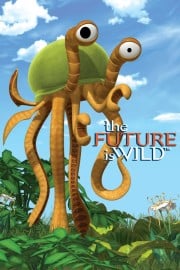
Ep 1. Electric Fisherman
- TV-G
- October 13, 2007
- 22 min
In the first episode of the television series The Future is Wild, entitled "Electric Fisherman," viewers are transported millions of years into the future to witness the incredible evolution of the world's creatures. The episode, much like the series as a whole, is structured as a nature documentary, with stunning visuals of the imagined prehistoric landscape and accompanying narration that describes the strange and wondrous creatures that inhabit it.
The story begins by introducing the first creature that audiences meet, a small, amphibious organism called a gannetwhale. This creature is unique in that it can both swim and fly, making it an incredibly versatile hunter that can catch prey both in the water and in the air. Despite its small size, the gannetwhale is a fearsome predator, and the episode's opening scenes show it hunting and eating a variety of small fish and insects.
As the episode progresses, viewers are introduced to a variety of other strange and wonderful creatures, including the skatersquid, a creature that glides and jumps through the air on specialized tentacles, and the ocean phantom, a graceful coral-like creature that filters the water for food. However, the real star of the episode is the electric fisherman, an enormous, multi-tentacled creature that generates electric shocks to stun and capture its prey.
At first glance, the electric fisherman might seem like a predator straight out of a horror movie, with its writhing tentacles and glowing, ominous eyes. However, the show's narration works hard to demystify the creature, explaining that it is simply another species doing what it must to survive and thrive in its environment. The electric fisherman itself is shown in great detail, with close-up shots of its tentacles and eyes that give viewers a sense of its scale and complexity.
Throughout the episode, there are also recurring themes of adaptation and evolution. The creatures of the imagined future world have each developed unique and unusual strategies for hunting and survival, from the airborne hunting of the gannetwhale to the lightning-fast tentacles of the electric fisherman. Viewers are invited to consider how these adaptations might have arisen over time, and how they might continue to evolve in the future.
Despite its fantastical nature, the Future is Wild series is grounded in the latest scientific thinking about how evolution works and how species interact with their environments. For example, in "Electric Fisherman," the show explains how the creature's electric shock abilities are similar to those of real-life electric fish, such as the electric eel. Throughout the episode, there is a constant sense of wonder and excitement at the amazing diversity of life that exists on the planet, both in the present and in the distant future.
Overall, the first episode of The Future is Wild is a captivating introduction to the series, full of stunning visuals and fascinating creatures. Whether you're a nature documentary fan or simply someone who loves to imagine what the world might look like in millions of years from now, this show is sure to fascinate and intrigue. So sit back, relax, and prepare to be transported to a world where anything is possible – where the future truly is wild.
